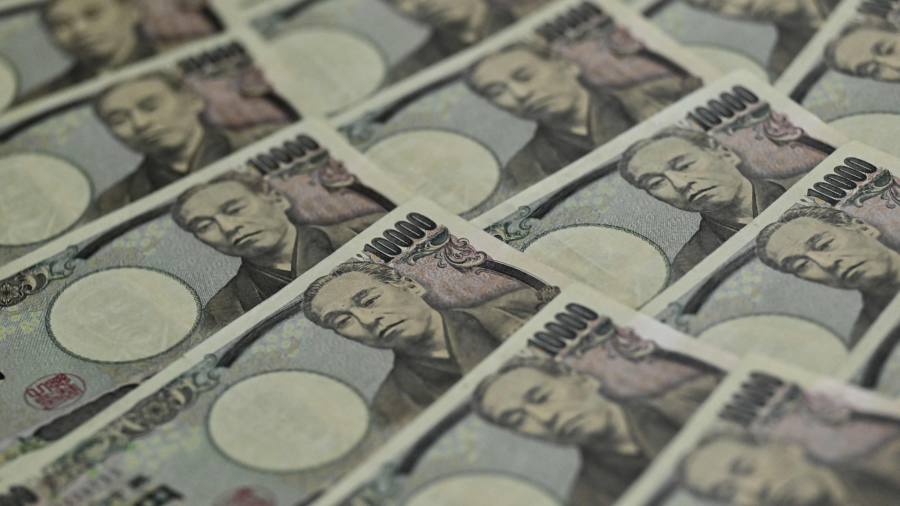Receive free Yen updates
We’ll send you a myFT Daily Digest email rounding up the latest Yen news every morning.
A sharp drop in the value of the yen is fuelling speculation among investors that Japanese authorities are preparing a “summer sequel” of massive market intervention to support the currency.
Finance minister Shunichi Suzuki said on Tuesday that the authorities were watching market moves “with a strong sense of urgency” and would “respond appropriately” if the drop became excessive.
A day earlier, Japan’s top currency diplomat Masato Kanda responded to reporters’ questions on the likelihood of intervention by saying he would not rule out any options.
The comments followed the yen’s decline to a level of about ¥143.50 against the dollar from ¥138.75 at the beginning of June as markets judged that the Bank of Japan was now unlikely to lift interest rates from just below zero this year.
“We think the risk of an intervention is high,” said Adam Cole, head of FX strategy at RBC Capital Markets, who added that the Japanese authorities were most concerned about import prices and the country’s high reliance on imported energy.
The yen remains stronger than levels of more than ¥150 to the dollar that triggered an effort to prop up the currency by selling $65bn of foreign reserves last October. That intervention, the first time the Japanese finance ministry had stepped into markets to bolster the yen in 24 years, came despite a widespread belief that Tokyo would avoid the risk of irritating the US with a unilateral move and sparked a three-month rebound in the currency.
Still, markets are now approaching the point where investors should be on alert, said currency strategists at Nomura. The yen began the year at just below ¥130 to the dollar. A weak currency helps to drive up inflation in Japan, which relies heavily on imported food and energy. While the BoJ seems relaxed about the recent inflationary burst — which could help it sustainably hit its 2 per cent inflation target after almost three decades struggling with deflation — sudden price rises can cause political problems for the government.
Currency analysts noted that in the days leading up to last year’s intervention Kanda had been far more direct in his warnings, and at one point was clear that the ministry of finance “could conduct stealth intervention”. The language so far this year, said Nomura Securities FX strategist Yujiro Goto, is not yet an indicator of an imminent move.
Others pointed out that the currency market was not as unbalanced now as it had been last year, when there was a huge build-up of speculative bets against the yen by global macro funds. Those positions had ballooned because of the rapidly expanding interest rate differential between the hawkish US Federal Reserve and the Bank of Japan’s unwavering commitment to its ultra-loose monetary policy.
Since April, the BoJ has had a new governor, Kazuo Ueda, but remains a global outlier among major central banks for keeping interest rates — and long-term bond yields — pinned close to zero in the face of rising consumer prices.
Benjamin Shatil, Japan FX strategist at JPMorgan, said that even if the Fed was now slowing its pace of rate increases, the persistence of the rate differential with the BoJ meant that intervention was unlikely to have much impact.
“If the policy rate is going to remain so low, it is hard to imagine the yen going much higher and it is entirely logical for the currency to weaken. I think the ministry of finance knows that,” said Shatil, who is forecasting that the yen will move to ¥152 against the dollar in the second half of the year.
Other currency analysts also said that while the new warnings had powerful echoes of the language used in the build-up to Japan’s record market intervention last year, the background circumstances this time were very different.
“We should certainly pay close attention to the escalated language but from a fundamental perspective, things have changed,” said Shusuke Yamada, chief Japan FX strategist at Bank of America. He noted that since Japan’s last intervention, oil prices were lower, benchmark Japanese equity indices have touched 30-year highs and Japan has reopened after the coronavirus pandemic to tourists arriving to take advantage of the weaker yen.
“For policymakers the cost benefit balance of a weaker yen may have improved,” said Yamada.
Read the full article here



